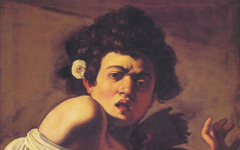Caravaggio’s Martyrdom of St. Ursula (1609-10)

Caravaggio, Martyrdom of St. Ursula (1609-10) Oil on canvas. Banca Intesa, Naples
Click image to enlarge.
Caravaggio's rendition of St. Ursula's execution shows the moment when a prince or king, having had his hand in marriage refused by the saint, shot her dead.1 Duncan Bull writes that, "If the space between Ursula and the Hun seems too close for the firing of an arrow, this only emphasizes the psychological verisimilitude" of "the prince's ambiguous reaction.."2 This typically brief dismissal of the ludicrous firing range should alert us.....
Click next thumbnail to continue
......to the underlying meaning of the bow and arrow. As in dozens of other examples on this site, the weapon represents the artist's "brush" as he examines and "paints" his canvas from close quarters.3 There is no mistake or "error" in the firing distance because the saint is "the archer's painting." It can be no coincidence, then, that the archer........
Click next thumbnail to continue

Left: Detail of Caravaggio's Martyrdom of St. Ursula (rotated)
Right: Detail of Anon., Engraving of Michelangelo after Giorgio Ghisi
Click image to enlarge.
......resembles Caravaggio's famous namesake, Michelangelo. Caravaggio had used a similar lined and time-worn face to represent Michelangelo in The Entombment, as shown separately. In both cases "Michelangelo" is the key protagonist "handling" or "shooting" the "painting".
Click next thumbnail to continue
Between "Michelangelo" and his "painting" of Ursula, a hand appears like God's, almost as if from nowhere, a foreshortened hand that like foreshortened hands in other paintings by Caravaggio represents the artist's craft. Appearing between the saint's potentially pregnant womb and the "archer", it indicates the need to combine conception with craft. Here Caravaggio implies that his own hand has made this painting of "Michelangelo" painting "Ursula" even though the archer is already an alter ego of the painter.
Click next thumbnail to continue
On the far right, scholars have long recognized the artist's actual self-portrait holding a spear (far left).4 The self-portrait appears in a similar role in the Taking of Christ, a painting which like this one is an allegory of painting (near left). The long, thin spear he holds is yet another symbol for a long, thin paintbrush. The artist thus appears three times: as Michelangelo in the archer, as the actual painter in the "disembodied" hand and as an onlooker in the youth, three different realities in one scene.
More Works by Caravaggio
Caravaggio executes his painting with a sword just as he executed a man

Caravaggio’s Judith and Holofernes (c.1599)
Notes:
1. Earlier versions of St. Ursula's martyrdom by other artists had almost invariably shown the saint accompanied by some of the 10,000 virgins who volunteered to share her fate
2. Bull, Rembrandt/Caravaggio (Amsterdam: Rijksmuseum) 2006, p. 131
3. Michael Fried is, I believe, the only art historian to have recognized that the short distance between the prince and Ursula is what he calls "painting distance." He adds that his phrase is meant "to evoke both the making and viewing of the picture." Fried, The Moment of Caravaggio, A.W. Mellon Lectures in the Visual Arts (Princeton University Press) 2010, p. 222
4. Bull, op. cit., p. 131
Original Publication Date on EPPH: 04 Apr 2012. | Updated: 0. © Simon Abrahams. Articles on this site are the copyright of Simon Abrahams. To use copyrighted material in print or other media for purposes beyond 'fair use', you must obtain permission from the copyright owner. Websites may link to this page without permission (please do) but may not reproduce the material on their own site without crediting Simon Abrahams and EPPH.





